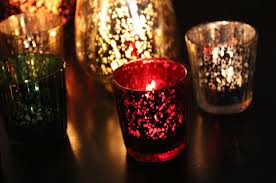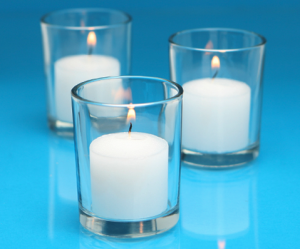Wednesday
Community ArticlesThe Life and Times…of Votive Candles
Not too long ago, the Shambhala Times had an article by Gordon Shotwell about tips for memorizing. To share these “good practices,” we decided to make it a quarterly column. We would love to hear from you about your tips for good practice! Please send any tips you would like to share to Ani Dawa Chotso, our Good Practice column editor.
On the Use and Care of Votive Candles Holders
Over the years and at various times, we’ve used different candles on our shrines: tapers, columns, paraffin oil candles, electric candles, butter lamps, and even an arrangement of christmas lights.
I love a candle – the scent, the flame. But, at home, I don’t use tapers or columns, or paraffin oil candles. Not even butter lamps. My favorite, by far, is the votive candle. You can use them with all the windows open with no fear of knocking them over. There are all sorts of holders to use in all sorts of colors. I especially enjoy colored votive holders, and at one time, kept a set of colored votive holders in my chopon kit.
I’ve cleaned lots of votive holders. Something about a used glass votive holder becoming shiny clean just agrees with me, and I find cleaning them satisfying and relaxing. Often, I volunteer to clean them, and folks walking by volunteer their favorite cleaning method. Here is what I have heard.
 First thought
First thought
It is much easier to clean a votive that has a bit of water added to the votive holder before adding the candle. Some folks say just add a tiny bit, while some say add as much as half an inch. I add about an eighth of an inch, just enough to cover the bottom with water. Whichever amount you use, the clean-up becomes significantly easier.
Freezing method
If you have the time and the space, one of the easiest methods is freezing. Wax contracts more than glass as it freezes, and as it cools, pops away from the side of the glass. Very often a quick shake will drop out all the wax.
To do this, make sure to let the votive holder cool completely down until the wax is solid. Then, place the votives in your freezer. As little as two hours can do the trick.
Microwave method
One of my all time favorites is to microwave the votives. This works especially well if you have little time and lots of votives to clean, although it is very nice for just one or two votives as well.
Place the votives upright on any solid, microwavable safe plate. Add two or three drops of dish soap to each votive, and fill them to the top with hot water. Microwave on high for a minute, or until the water in the votives is boiling. Using potholders or oven mitts, remove the plate from the microwave and let the water cool for a minute. (This is when I would put the second plate in, if there were that many votives for cleaning.)
What happens is the soap combines with the wax and forms little white balls that feel like grit (these will not clog your drain!). I put a paper towel over the drain of the sink, and (carefully!) pour the still hot water down the drain through the paper towel. Then all that needs to be done is drying with a clean towel or newsprint and you’re done.
Oven method
I have never done this, but others have mentioned that it works for them, especially when there are lots of votives to be cleaned.
Thoroughly line a cookie sheet with aluminum foil, on top of that add old newspapers or paper plates. The aluminum foil protects your cookie sheet, the paper soaks up the wax protecting you from running wax while moving the pan.
If there are any bits of metal, remove them from the votives. Then place the votives on the cookie sheet, upside down.
Place the cookie sheet with votives in your oven, set to it’s very lowest setting (175 to 200 degrees, no more).
Check the votives frequently, removing with a potholder the ones whose wax has completely melted or fallen out. Wipe them immediately with clean paper towels or newsprint.
Allow the melted wax on the tray to cool then just discard with the paper and aluminum foil.
No-clean methodLast but not least, there is what I think of as the no-clean method or faux votive candle. You can take your votive holder and fill it 2/3 of the way with sand or rice. Then tuck a tea light into it. You get almost the same effect as a full size votive candle, and there is no clean up. This is the method I use most when on retreat.
Your method
It would be lovely to hear of any methods you use. Please email us your techniques and stories!
 ~~
~~
Have Good Practice tips for us? We would love to hear from you about your tips for good practice! Please send any tips you would like to share to Ani Dawa Chotso, our Good Practice column editor.
Ani Dawa Chotso has been a Shambhalian since 1984, and a nun for the last ten years. She lives in St Johnsbury VT (quite close to Karme Choling) and absolutely loves working with the Shambhala Times staff!







Jan 13, 2014
Reply
Great tips & I’ve one more to add to the wax cleanup list.
Pour HOT coffee over candlesticks, etc. – the acid or some chemical in the coffee “cuts thru & melts away” the wax just as it is said to clear the cobwebs in the morning!